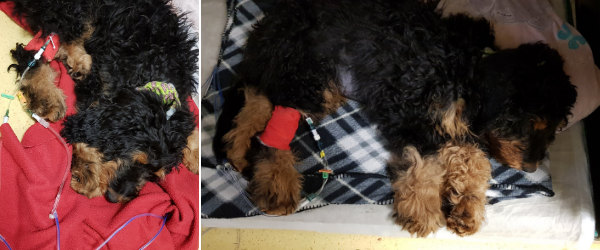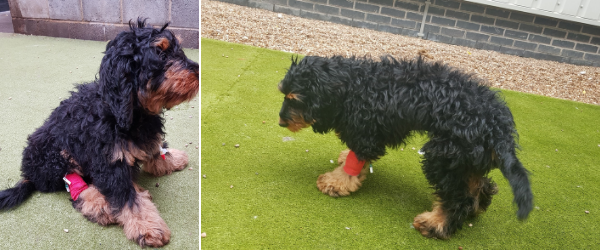Background & Symptoms
Teddy a 5-month old Bernese Mountain Cross, came to see us as he was feeling unwell.
His owners reported that he was lethargic, not eating, drinking, passing soft faeces and was whining, whenever the owners picked him up, he was unwilling to move by himself; and when he did, he was stiff.
They felt his condition had deteriorated gradually and so brought him along to Pride Veterinary Centre to see one of our first opinion vets.
After a thorough clinical exam, during which Teddy was unwilling to stand with his front limbs and had a high temperature, it was felt that he should be admitted to the hospital for bloods to be taken, intravenous fluid therapy; to help with his high temperature, pain relief and further investigations, which included an abdominal ultrasound to rule out gastrointestinal causes and radiographs to assess his limbs.
Within the first day of his hospitalisation his condition deteriorated, so that he was unwilling to move at all; he was in a lot of pain. His pain relief was increased to make him more comfortable and ultrasound and radiographs carried out.

Diagnosis
Metaphyseal Osteopathy was diagnosed, a condition that can affect young, large/giant breed dogs, usually around 3-4 months of age.
What Is Metaphyseal Osteopathy?
The condition affects the metaphyseal of the long bones e.g. femur, tibia, radius, ulna, which contains the growth plates and causes inflammation. This causes pain, pyrexia, reluctance to move and diarrhoea.
Although there are many theories on what causes the condition, the cause of Metaphyseal Osteopathy is still unknown.
Teddy's Treatment & Recovery
Teddy was with us for nine days and within this time the ward nurses cared for him, monitoring his comfort levels to ensure he was not in pain, cleaning and grooming him, feeding him via a feeding tube, as well as tempting him to eat on his own.
Gentle physiotherapy was used to ensure his muscles kept working, encouraging him to move, sit up and eventually stand; as well as ensuring he got plenty of cuddles. Although so uncomfortable, Teddy never really complained unless picked up and most of the time would still wag his tail to great the nurses and vets.

Gradually with lots of encouragement, Teddy began to improve and started to sit up by himself and no longer yelped when being placed in standing position; with the time between him standing unaided and laying back down, increasing every day.
On day six, with lots of encouragement (and chicken), he took his first tentative steps outside! From then on Teddy came on leaps and bounds and on day nine of his hospitalisation, he was able to go home to continue his recovery, ensuring regular check-up appointments were made, to monitor his progress.